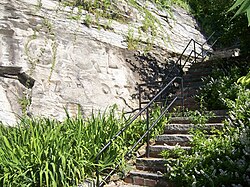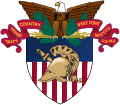| Kosciuszko's Garden | |
|---|---|
 Steps leading up from the garden, July 2008 | |
| Location | West Point, New York |
| Nearest city | Highland Falls, New York |
| Coordinates | 41°23′31″N73°57′13″W / 41.391858°N 73.953583°W |
| Created | 1778 |
| Operated by | Federal government |
Kosciuszko's Garden is a small retreat garden built by Tadeusz Kosciuszko on the side of a cliff overlooking the Hudson River at West Point, New York. [1] First constructed in 1778, it still offers visitors and cadets a place of quiet tranquility during the warmer months. [2] The "General Edward L. Rowny Family Endowment" was established to further sustain perpetual care and maintenance of the Garden and to dedicate a plaque commemorating the occasion.
Dr. James Thacher described it in his diary, "Colonel Thaddeus Kosciuszko, a gentleman of distinction from Poland...amused himself while stationed on the point, in laying out a curious garden in a deep valley, abounding more in rocks than soil. I was gratified in viewing his curious water fountain with jets and cascades." [3] : 71






